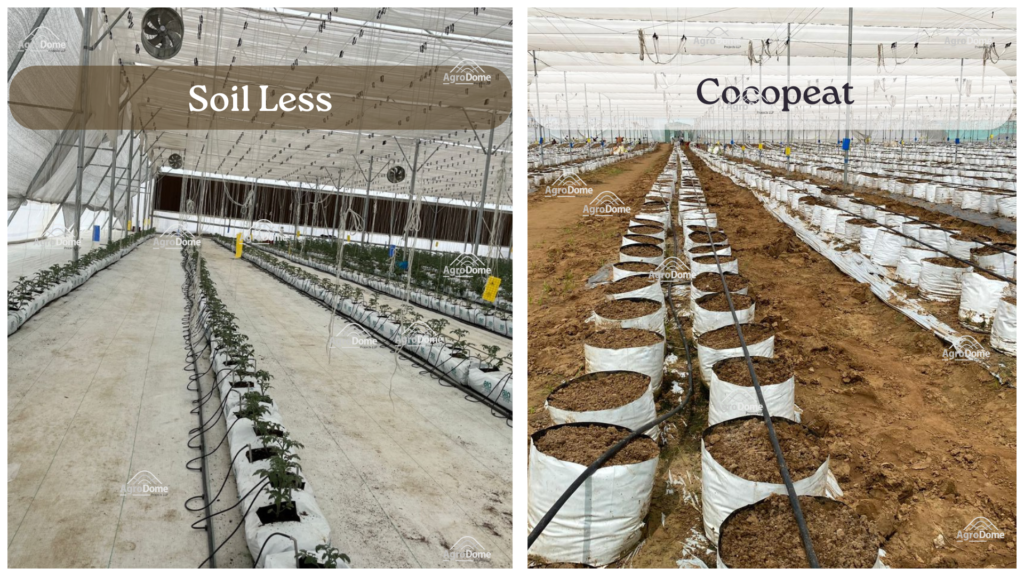Growing vegetables in a polyhouse offers higher yields, better quality, and protection from extreme weather. But one of the most important decisions a grower has to make is choosing the right growing medium. Two of the most popular options are cocopeat and soil.
In this blog, we’ll explore the key differences between cocopeat and soil-based farming in polyhouse cultivation—and help you decide which one is right for your needs.
🧱 What is Cocopeat?
Cocopeat is a natural fiber extracted from coconut husk. It’s an excellent growing medium used in soilless cultivation. Thanks to its superior water-holding capacity and sterile nature, cocopeat is gaining popularity among polyhouse farmers.
🌱 Cocopeat-Based Cultivation: Pros & Cons
✅ Advantages:
- Sterile and Disease-Free: Cocopeat is free from soil-borne pathogens, reducing the risk of disease.
- Excellent Moisture Retention: Holds water well but also provides good drainage, creating a healthy root zone.
- Lightweight & Easy to Handle: Makes setup and maintenance easier.
- Uniform Structure: Promotes even root development.
- Perfect for Fertigation: Allows precise nutrient delivery through drip irrigation.
❌ Disadvantages:
- No Natural Nutrients: Requires regular fertilization, as cocopeat doesn’t contain any inherent nutrients.
- Initial Investment: Slightly higher cost due to the need for media and fertigation setup.
- Salt Buildup: Needs flushing from time to time to prevent salt accumulation.
🌾 Soil-Based Cultivation: Pros & Cons
✅ Advantages:
- Naturally Nutrient-Rich: Contains some essential nutrients for plant growth.
- Low Initial Cost: Utilizes available soil, reducing upfront expenses.
- Organic-Friendly: Easier to incorporate organic manures and composts.
❌ Disadvantages:
- Soil-Borne Diseases: Higher risk of pests and pathogens unless treated properly.
- Inconsistent Texture & Fertility: Variability in soil quality can affect crop uniformity.
- Compaction Issues: Over time, soil can harden, affecting root health.
- Less Precision in Nutrient Control: Compared to cocopeat and fertigation systems.
🏆 So, Which One Should You Choose?
- Choose cocopeat if you’re aiming for high-value crops, better disease control, and precision fertigation.
- Choose soil if you’re looking for a low-cost setup, prefer organic cultivation, or already have healthy, treated soil in your polyhouse.
🌟 Final Thoughts
Both cocopeat and soil have their own strengths and drawbacks. Your choice should depend on your crop type, budget, and long-term goals. For farmers looking to maximize quality and yield in polyhouse farming, soilless systems using cocopeat are increasingly the preferred option.
Have questions or need help deciding what’s best for your polyhouse setup? Contact us for personalized guidance!

📞 𝗖𝗼𝗻𝘁𝗮𝗰𝘁 us to explore innovative solutions in agriculture, greenhouse farming, and beyond!
📺 𝗦𝘂𝗯𝘀𝗰𝗿𝗶𝗯𝗲 𝘁𝗼 𝗼𝘂𝗿 𝗬𝗼𝘂𝗧𝘂𝗯𝗲 𝗖𝗵𝗮𝗻𝗻𝗲𝗹: https://lnkd.in/dPPeircY
📱 𝗙𝗼𝗹𝗹𝗼𝘄 𝗨𝘀 𝗼𝗻 𝗦𝗼𝗰𝗶𝗮𝗹 𝗠𝗲𝗱𝗶𝗮: https://lnkd.in/dTaj7wrE
📧 𝐄𝐦𝐚𝐢𝐥: info@agrodome.in
📱 𝐏𝐡𝐨𝐧𝐞: +91 9898173376, +91 9033003257
PolyhouseFarming #SoillessFarming #CocopeatCultivation #GreenhouseFarming #PrecisionFarming #HorticultureInnovation #SustainableAgriculture #HighValueCrops #ModernFarming #OrganicFarming #Fertigation #ControlledEnvironmentAgriculture #AgriTech #UrbanFarming #BitterGourdFarming #CucumberFarming #FarmersFirst #GrowWithTech

